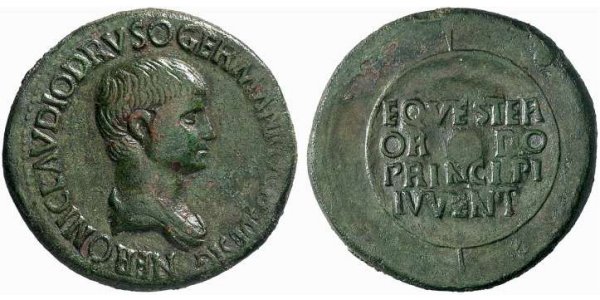
Numismatica Ars Classica NAC AG >Auction >Auction 25 (25.06.2003)
 |
| 写真提供:Numismatica Ars Classica NAC AG
|
 超拡大ボタン 超拡大ボタン |
| |
|
|
|
Numismatica Ars Classica NAC AG >Auction >Auction 25 (25.06.2003)
Lot :379
Price :6400 CHF (~4822 USD)
Description
The Roman Empire
Nero Caesar, 50-54
No.: 379
Schatzpreis - Estimate CHF 8000
d=34 mm
Sestertius, Thrace circa 50-54, 20.80 g. NERONI CLAVDIO DRVSO GERMANICO COS DESIG Bare-headed and draped bust r. Rev. EQVESTER / OR DO / PRINCIPI / IVVENT on shield with vertical spear behind. RIC Claudius 108 (Rome). BMC pl. 37, 4. C 99. CBN 288. von Kaenel, pl. 25, 37 (these dies).Very rare and in exceptional condition for this issue.Light green patina and very fine
An acknowledged rarity among Julio-Claudian bronzes, this sestertius was struck for Nero after his adoption by Claudius. All of Nero’s pre-accession coins feature Nero’s bare-headed bust on the obverse, and either an inscribed shield or a display of priestly implements on the reverse. These reverse designs and their inscriptions refer to Nero’s introduction into the high priesthoods and his promotion by Claudius as princeps iuventutis and consul designate. Since Claudius struck Imperial aurei and denarii, cistophori, sestertii and asses for Nero, but only Imperial sestertii for Britannicus, few at the time could have doubted that Claudius favored his adopted son Nero over his natural son Britannicus. This state of affairs has always perplexed historians, as the reasons for Claudius’ decision are unknown.
Pre-accession coins were struck for Nero at no fewer than a dozen provincial mints and at what appears to be three Imperial mints: Rome/Lugdunum for aurei and denarii, Ephesus or another Asiatic mint for cistophori, and a Thracian mint for sestertii and asses. Though opinion on complicated matters such as these is ever-evolving, we should presume this sestertius was struck at an Imperial branch mint in the Balkans, and that it is linked with two other rare and important bronzes: sestertii of Nero’s mother Agrippina Junior and of Claudius’ natural son Britannicus. Though the latter has been attributed in RIC and BMCRE to Titus’ restoration bronzes, it seems better to associate them with the Balkan sestertii of Agrippina and Nero. Recent scholarly opinion is generally supportive of this because of the similar style and fabric of the three issues, their find-spots, and the greater historical probability of Britannicus’ sestertii being Claudian rather than Flavian "
show10goo 無断転用を禁止します。
| 
